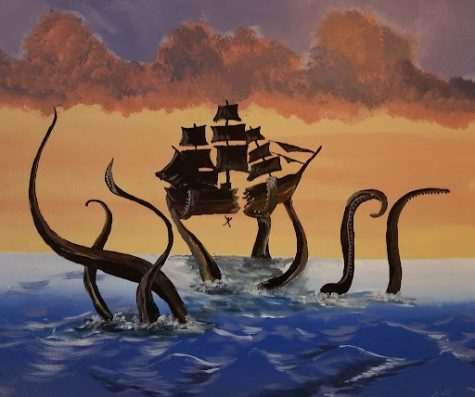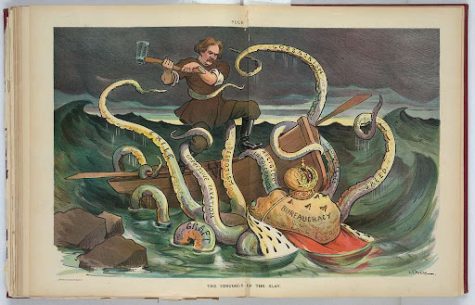Mysteries, Oddities, and Everything Strange: Kraken
February 25, 2022
Kraken: An Unimaginably Massive Squid
The ocean can be pretty terrifying. Imagine being surrounded by never-ending waves in every direction, with thousands of feet below filled with alien creatures and unimaginable terrain. Because of this uninterpreted wonder, many have speculated about what could possibly be hiding underneath the surface of the water. Maybe some sort of humanoid fish species with magnificent voices or some sort of living dinosaur. Maybe even a blob fish exists down there somewhere. But possibly one of the darkest and most overwhelming monsters of the deep comes in the form of the Kraken. Portrayed as the villain in many sailors’ tails and illustrations, one might wonder how humanity dreamt of such a massive and terrifying creature. So what is the Kraken, where does it come from, and more importantly—does it exist? Should you be terrified whenever you step out onto the sand, or is it merely a sailors’ tale?
 The Kraken is most notably portrayed as an enormous Giant Squid. It is unbelievable that any creature can grow bigger than an animal whose name describes its size, but somehow it was imagined. Legends state the Kraken was able to consume whole ships in one gulp and attack them with its excessively powerful limbs. The first account of the Kraken goes back to 1180 with Norwegian King Sverre. In 1180, braving the sea was not for the faint of heart. An endless void of waves and water with unimaginable creatures underneath was only for those who were brave enough to take a chance. It remained a sailor’s legend for over half a millennium.
The Kraken is most notably portrayed as an enormous Giant Squid. It is unbelievable that any creature can grow bigger than an animal whose name describes its size, but somehow it was imagined. Legends state the Kraken was able to consume whole ships in one gulp and attack them with its excessively powerful limbs. The first account of the Kraken goes back to 1180 with Norwegian King Sverre. In 1180, braving the sea was not for the faint of heart. An endless void of waves and water with unimaginable creatures underneath was only for those who were brave enough to take a chance. It remained a sailor’s legend for over half a millennium.
Its first written account was by Italian author Francesco Negri in his 1700 novel Viaggio settentrionale (roughly translating to Northern Travel), described as a horned fish with countless arms. In 1753, historian Erik Ludvigsen Pontoppidan denoted the creature as a massive starfish, crab, or octopus. Pontoppidan’s writings are credited with the first use of the name “Kraken” in his work Det første Forsøg paa Norges naturlige Historie (meaning The First Attempt at a Natural History of Norway). Pierre Denys de Montfort created the first illustrations of the Kraken wrecking a ship with its tentacles, and from there the image of a squid was popularized to describe the sea beast.
squid was popularized to describe the sea beast.
A Swedish zoologist by the name of Carl Linnaeus set out in 1753 to identify every creature alive on Earth. In his Systema Naturae, he listed the Kraken as a cephalopod known as a Microcosmus marinus, with all the traits of a giant squid. Later entries of the book omitted the animal, but its mark on the edition still stood. Ancient maps included doodles of the Kraken wreaking havoc on the seas around the world with its giant tentacles and beady eyes. The tales of its existence kept so-called “cowards” from braving the seas and were passed from generation to generation as folk tales.
As the tales progressed over the years, the Kraken’s massive legend dwindled to a more reasonable size. People became eager to witness the Kraken in its full force, and they wanted to be near it as it swam around massive schools of fish that would make a good profit. According to supposed biologists, Krakens would not  have been so eager to interact with humans, only doing so when forced to. This reclusion is common of many legendary creatures, with believers using it as an excuse for their rarity and isolation.
have been so eager to interact with humans, only doing so when forced to. This reclusion is common of many legendary creatures, with believers using it as an excuse for their rarity and isolation.
Although the Kraken isn’t too severe of a terror anymore, its appearance in pop culture is quite common. Alfred Tennyson crafted a sonnet known as “The Kraken” about the said squid, and the 1981 movie Clash of the Titans starred the large monster. Icelandic legend has perpetuated the creature’s existence for decades, and it even made a cameo in one of the largest film series in history, Pirates of the Caribbean. At the current time, it is clear these delusions of the largest animal to exist is simply a massive exaggeration of the already existing giant squid, the night terrors sailors suffered at the the thought of being swallowed whole at sea still have their impact. Even though sailors no longer fear the appearance of a Kraken, its history is undeniable, and it will still perpetuate its existence for generations to come as tales get transferred to posterity.
Resources:
https://en.wikipedia.org/wiki/Kraken
https://historydaily.org/the-kraken-norse-legend-or-recently-discovered-creature
http://www.unmuseum.org/kraken.htm
https://www.greekboston.com/culture/mythology/kraken-scylla/














































